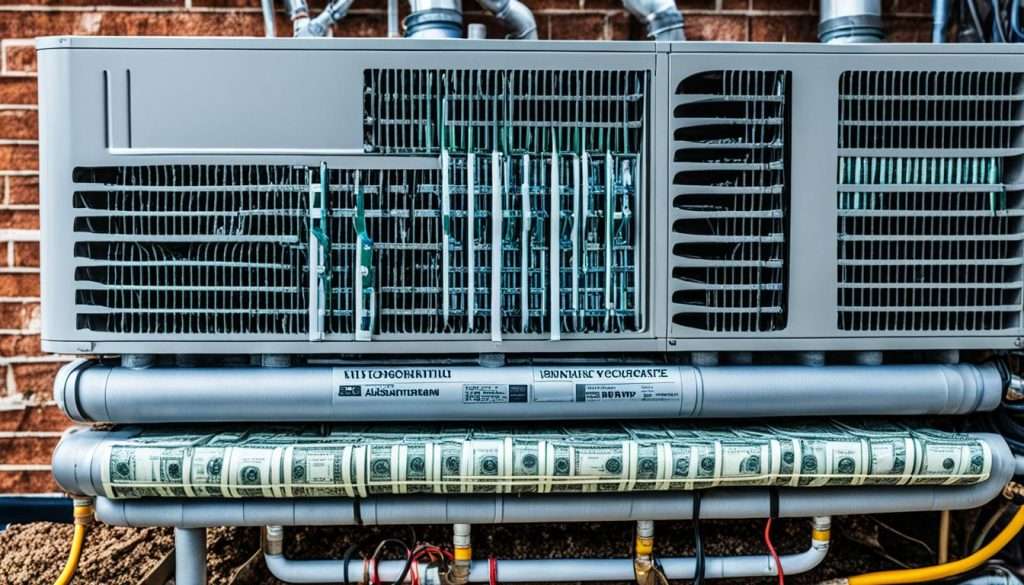Did you know that the cost of new HVAC systems has been steadily increasing in recent years? It’s not just your imagination—HVAC prices have been soaring, leaving homeowners wondering why these essential systems are becoming more and more expensive. In this article, we’ll dive into the factors that contribute to the high cost of new HVAC systems. From government regulations and supply chain disruptions to technological advances and labor shortages, we’ll explore the various reasons behind the pricey HVAC units.
Key Takeaways:
- Government regulations and compliance requirements contribute to the high cost of new HVAC systems.
- Inflation and the increasing cost of raw materials, such as steel and aluminum, impact HVAC prices.
- Supply chain disruptions caused by the COVID-19 pandemic have led to material shortages and increased costs for HVAC systems.
- Tariffs and trade wars impact the pricing of HVAC systems due to increased manufacturing costs.
- Technological advances and advanced features in HVAC systems drive up their overall cost.
Understanding the Rising Costs of HVAC Systems
The rising costs of HVAC systems can be attributed to several factors. In this section, we will explore the impact of government regulations on manufacturing, the effect of inflation and raw material costs, and the supply chain disruptions caused by the COVID-19 pandemic.
Impact of Government Regulations on Manufacturing
Government regulations, such as energy-efficiency requirements and environmental regulations, play a significant role in driving up the costs of HVAC systems. HVAC manufacturers need to comply with these regulations, which often involve investing in advanced technologies and materials. These additional requirements increase the overall cost of production.
Inflation and the Cost of Raw Materials
Another factor contributing to the rising costs of HVAC systems is inflation and the increasing cost of raw materials. Materials such as steel, aluminum, and refrigerants are essential for HVAC manufacturing. As the prices of these materials rise, it directly impacts the cost of producing HVAC systems. Manufacturers are forced to pass on these increased costs to consumers.
Supply Chain Disruptions from the COVID-19 Pandemic
The COVID-19 pandemic has had a significant impact on the HVAC supply chain, resulting in additional cost implications. Material shortages, labor shortages, and increased transportation costs have disrupted the supply chain. These disruptions have led to delays in manufacturing and increased prices for HVAC systems. As the industry recovers and adjusts to the challenges caused by the pandemic, it is expected that these cost impacts will continue to be felt.
Overall, the rising costs of HVAC systems can be attributed to a combination of factors, including government regulations, inflation and raw material costs, and supply chain disruptions. As consumers, it is essential to understand these factors to make informed decisions about HVAC purchases and explore affordable options without compromising on quality and performance.
Ripple Effect of Tariffs and Trade Wars on Pricing
Tariffs and trade wars have had a significant impact on the pricing of HVAC systems. The imposition of tariffs on imported steel and aluminum, which are essential materials for HVAC manufacturing, has increased the cost of production for HVAC manufacturers. These increased costs are ultimately passed on to consumers, resulting in higher prices for HVAC systems.
Additionally, trade tensions between countries, particularly between the United States and China, have disrupted the global HVAC supply chain, leading to further supply chain disruptions and increased costs for HVAC systems.
Technological Advances and Their Price Tags
Technological advances in HVAC systems have played a significant role in shaping the current landscape of the industry. These advances have brought about many benefits, such as improved energy efficiency, enhanced comfort, and increased convenience for homeowners. However, they have also contributed to the rising costs of HVAC systems.
Energy Efficiency and Compliance with New Standards
One of the major driving forces behind the increasing cost of HVAC systems is the demand for energy efficiency. With growing concerns about environmental sustainability and the need to reduce energy consumption, HVAC manufacturers have had to invest in new technologies and components that meet stringent energy efficiency standards.
Government regulations, such as the Energy Policy Act of 2005 and the American Clean Energy and Security Act of 2009, have set guidelines and requirements for HVAC systems to ensure their energy efficiency. These regulations have prompted manufacturers to develop and incorporate advanced features and components that reduce energy consumption and minimize environmental impact.
While these energy-efficient technologies are beneficial in the long run, they come with a higher price tag. The cost of research and development, as well as the production and implementation of these advanced features, adds to the overall cost of HVAC systems.
Cost Implications of Advanced HVAC Features
In addition to energy efficiency, HVAC systems now come equipped with advanced features that enhance comfort, convenience, and indoor air quality. These features include smart thermostats, zoning capabilities, and improved air filtration systems.
Smart thermostats allow homeowners to remotely control and program their HVAC systems, optimizing energy usage and reducing utility bills. Zoning capabilities enable different areas of a home to be heated or cooled independently, maximizing comfort and energy efficiency. Improved air filtration systems help remove allergens, pollutants, and contaminants from the indoor air, contributing to better indoor air quality.
While these advanced features greatly enhance the functionality and performance of HVAC systems, they also come at an additional cost. The development, integration, and maintenance of these features require specialized technologies and components, which contribute to the overall price of HVAC systems.
The Labor Shortage and Its Influence on HVAC Costs
The HVAC industry is currently grappling with a significant labor shortage, which has had a direct impact on the costs associated with HVAC systems. The shortage of skilled HVAC technicians and installers has led to increased labor costs, as companies compete to attract and retain a limited workforce. As a result, higher wages and increased training expenses are passed on to consumers, resulting in higher prices for HVAC systems.
The impact of the labor shortage goes beyond just higher costs. It also leads to delays in HVAC system installation and service, further impacting the overall cost. With fewer technicians available to handle the growing demand for HVAC systems, customers may experience longer wait times, reducing the efficiency and convenience of HVAC services.
The workforce challenges in the HVAC industry pose a significant hurdle, as demand for HVAC systems continues to rise. According to the U.S. Bureau of Labor Statistics, the demand for HVAC technicians is expected to grow by 4% from 2019 to 2029, faster than the average for all occupations. However, the limited pool of skilled workers presents a critical obstacle to meeting this demand.

Materials Shortage: Metals and Electronics in HVAC
The HVAC industry is currently facing shortages of essential materials, such as steel, aluminum, and semiconductors, which are significantly impacting the cost of HVAC systems. These shortages have led to an increase in prices for HVAC units, making them more expensive for consumers.
Steel and Aluminum Import Tariffs
One of the key factors contributing to the materials shortage in the HVAC industry is the imposition of tariffs on imported steel and aluminum. The tariffs have raised the cost of these materials for HVAC manufacturers, leading to higher production costs. Consequently, these increased costs are passed on to consumers in the form of higher HVAC prices.
Semiconductors and Refrigerants: Supply vs. Demand
In addition to steel and aluminum shortages, there is also a global semiconductor shortage affecting the HVAC industry. Semiconductors are vital components in HVAC systems, and their scarcity has resulted in increased prices for these units. Supply chain disruptions and a surge in demand from other industries have compounded the problem, resulting in further price hikes for HVAC systems.
Overall, the materials shortage in the HVAC industry, particularly of steel, aluminum, and semiconductor components, has had a significant impact on the pricing of HVAC systems. The import tariffs on steel and aluminum, as well as the global semiconductor shortage, have driven up production costs and subsequently increased prices for consumers. As a result, it is important for homeowners to be aware of these factors when considering the cost of HVAC systems.
How Market Demand Affects HVAC Pricing
Market demand plays a crucial role in determining HVAC prices. When there is high demand for HVAC systems, manufacturers may increase prices to maximize profits. Factors such as population growth, new construction projects, and renovations drive demand for HVAC systems, influencing pricing in the market.
External Factors Contributing to HVAC Expense
External factors play a significant role in the overall expense of HVAC systems. Two key factors that contribute to the cost are the lifespan of HVAC units and climate change.
HVAC Unit Lifespan and the Need for Upgraded Equipment
HVAC units typically have a lifespan of 15-20 years. After this period, they may require replacement or upgrades. Upgraded equipment, such as more energy-efficient units or advanced features, adds to the overall cost of HVAC systems. While regular maintenance and proper care can extend the lifespan of HVAC units, eventually, homeowners will need to consider investing in new equipment to ensure optimal performance and efficiency.
Climate Change and the Increasing Need for HVAC Systems
The impact of climate change is another external factor that affects HVAC costs. As extreme weather events become more frequent, the demand for heating and cooling systems rises. Higher temperatures and severe weather conditions increase the need for reliable HVAC solutions, resulting in higher prices as the market adapts to accommodate the growing demand.
By understanding these external factors and their influence on HVAC costs, homeowners can make informed decisions about their HVAC systems. While the expense of HVAC systems may be influenced by factors beyond their control, exploring energy-efficient options and regular maintenance can help mitigate costs over time.
Conclusion
In conclusion, the rising costs of HVAC systems can be attributed to a combination of factors. Government regulations, such as energy-efficiency requirements and environmental standards, have increased manufacturing costs for HVAC systems. Inflation and the increasing cost of raw materials, such as steel and aluminum, have also contributed to the higher prices. Supply chain disruptions caused by the COVID-19 pandemic have further impacted the availability of materials and increased transportation costs.
Furthermore, tariffs and trade wars have had a significant impact on HVAC pricing, with increased costs resulting from tariffs on imported materials. Technological advances in HVAC systems, while beneficial for energy efficiency and improved features, come with a higher price tag. The labor shortage in the HVAC industry has led to increased labor costs and delays in installation and service.
Materials shortages, including steel, aluminum, and semiconductors, have also played a role in driving up the cost of HVAC systems. Market demand and external factors such as HVAC unit lifespan and climate change have further influenced pricing. Understanding these factors can help homeowners make informed decisions and explore affordable options without compromising quality and efficiency.
If you are in the South Jersey area of Camden County, Gloucster County, Burlington County and Atlantic County contact our HVAC company for a Free estimate on a complete HVAC system we have the best prices at D’Auria & Son Heating and Air.
FAQ
Why are new HVAC systems so expensive?
There are several factors that contribute to the high cost of new HVAC systems, including government regulations, manufacturing costs, supply chain disruptions, tariffs and trade wars, technological advances, labor shortages, materials shortages, market demand, and external factors like HVAC unit lifespan and climate change.
How do government regulations impact the cost of HVAC systems?
Government regulations, such as energy-efficiency requirements and environmental regulations, increase manufacturing costs for HVAC systems. Compliance with these regulations requires HVAC manufacturers to invest in advanced technologies and materials, which drives up the overall cost of production.
What role does inflation and the cost of raw materials play in HVAC prices?
Inflation and the increasing cost of raw materials, such as steel, aluminum, and refrigerants, contribute to the rising prices of HVAC systems.
How does the COVID-19 pandemic affect the cost of HVAC systems?
The COVID-19 pandemic has caused disruptions in the HVAC supply chain, leading to material shortages, labor shortages, and increased transportation costs, all of which impact the overall cost of HVAC systems.
Are tariffs and trade wars responsible for the high cost of HVAC systems?
Yes, tariffs on imported steel and aluminum, as well as trade tensions between countries, have increased the cost of production for HVAC manufacturers. These increased costs are ultimately passed on to consumers, resulting in higher prices for HVAC systems.
How do technological advances contribute to the high cost of HVAC systems?
The push for energy efficiency and compliance with new standards requires HVAC manufacturers to invest in new technologies and components, increasing the overall cost of HVAC systems. Advanced features in HVAC systems, such as smart thermostats and improved air filtration systems, also come with a higher price tag.
How does the labor shortage impact HVAC costs?
The shortage of skilled HVAC technicians and installers has increased labor costs, as companies compete for a limited workforce. Higher wages and increased training costs are passed on to consumers, resulting in higher prices for HVAC systems.
How do material shortages affect the cost of HVAC systems?
The tariffs imposed on imported steel and aluminum have increased the cost of these materials for HVAC manufacturers. Additionally, the global shortage of semiconductors, a key component in HVAC systems, has further increased the cost of HVAC systems.
Does market demand influence HVAC pricing?
Yes, when there is high demand for HVAC systems, manufacturers may increase prices to maximize profits. Factors such as population growth, new construction projects, and renovations drive demand for HVAC systems, influencing pricing in the market.
What external factors contribute to the expense of HVAC systems?
External factors, such as the lifespan of HVAC units and climate change, contribute to the expense of HVAC systems. HVAC units typically have a lifespan of 15-20 years, after which they may need to be replaced or upgraded. Additionally, climate change and extreme weather conditions increase the demand for HVAC systems, driving up prices as the market responds to increased needs for heating and cooling solutions.





